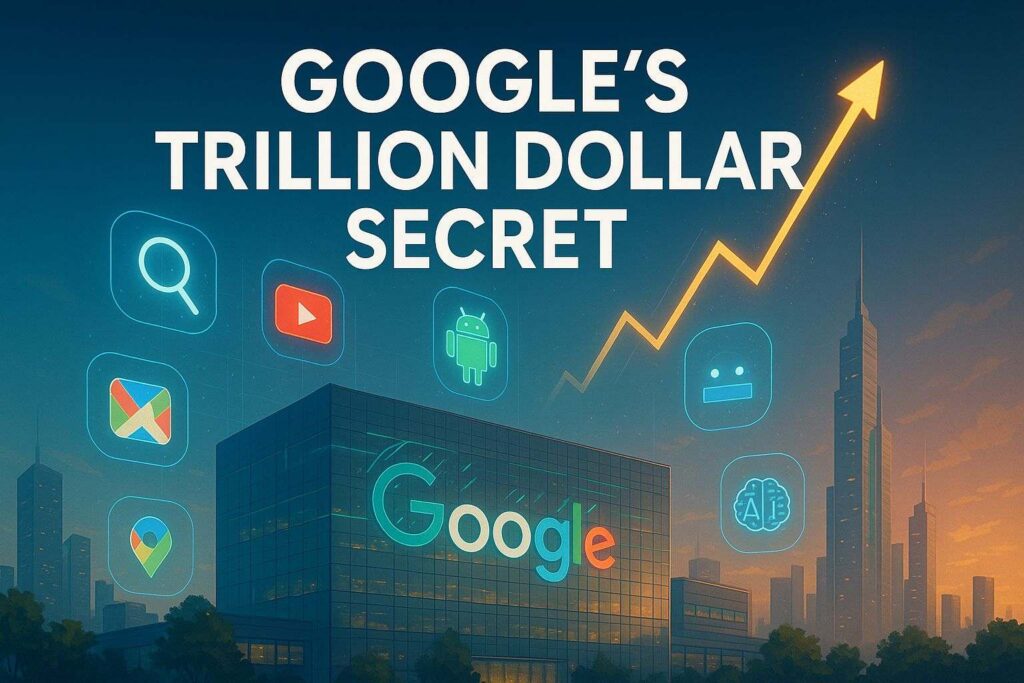How Google Became a Trillion Dollar Company Without Charging You a Cent

In an era where digital interaction is as fundamental as breathing, Google stands as an undisputed titan, seamlessly integrated into nearly every facet of our online existence. From the moment we seek information to the instant we navigate our world, its services are ubiquitous, often provided at no direct cost to the user. This seemingly paradoxical generosity has allowed Google to achieve a market valuation exceeding $2 trillion, prompting a crucial question: How does Google offer so much for free, yet become one of the most valuable entities on the planet? The answer lies in a sophisticated, multi-faceted business model that has redefined commerce and information exchange in the 21st century. This article delves into the intricate mechanisms behind Google’s success, exploring its core revenue streams, strategic expansions, and the evolving challenges it faces in an increasingly privacy-conscious and AI-driven world.
The Foundation: Search and Advertising
At the heart of Google’s digital empire lies its foundational product: the search engine. What began as a college project in 1998 with the ambitious mission to organize the world’s information and make it universally accessible and useful, quickly evolved into the primary gateway to the internet for billions. The simplicity of its interface, contrasting sharply with the cluttered web portals of its early competitors, was a key factor in its rapid ascent. This minimalist design, prioritizing the search bar, ensured a seamless user experience, fostering unparalleled engagement.

The genius of Google’s business model emerged with the introduction of an advertising system, initially known as AdWords and now as Google Ads. This innovation allowed businesses to bid for prominent placement of their advertisements on search results pages. This pay-per-click model, where advertisers are charged only when a user interacts with their ad, proved incredibly effective. It transformed the search engine from a mere information retrieval tool into a powerful advertising platform, generating the vast majority of Google’s revenue.
In 2022, for instance, a staggering 58% of its total revenue, amounting to $162 billion, was derived from search-related advertisements. This core revenue stream has demonstrated nearly exponential growth over the past two decades, with significant surges observed during periods of increased online activity, such as the COVID-19 pandemic, when more individuals spent time on the internet, leading to higher ad consumption and increased advertiser spending.
Expanding Horizons: YouTube, Android, and Beyond
While search advertising remains the bedrock, Google’s strategic expansion into diverse product and service offerings has solidified its dominance. Key acquisitions and organic innovations have created a vast ecosystem that further fuels its advertising machine and opens new revenue avenues. In 2004, Gmail revolutionized email with its generous storage capacity, followed by Google Maps in 2005, which transformed navigation and location- based services. A pivotal moment arrived in 2006 with the acquisition of YouTube, a platform that was already a burgeoning force in online video.
This foresight recognized the growing importance of video content and integrated it into the broader ecosystem, creating another powerful advertising channel. YouTube ads, whether pre-roll, mid-roll, or banner, contribute significantly to Google’s revenue, generating approximately $29 billion in 2022. This revenue is shared with content creators, fostering a vibrant creator economy that in turn drives more engagement and ad impressions. The strategic foresight continued with the introduction of Android in 2008, a mobile operating system that now powers the majority of the world’s smartphones.

This move ensured Google’s presence on mobile devices, a critical frontier for internet access and content consumption. The same year saw the launch of Google Chrome, which rapidly became the world’s most popular web browser, further cementing its control over the digital user experience. Beyond software, Google ventured into hardware with products like Pixel smartphones, Chromebook laptops, and smart home devices, diversifying its offerings and creating new touchpoints for users. It’s important to note that not every venture has been a resounding success.
Google has a long list of discontinued products and services, including social media attempts like Google Plus, messaging apps like Google Hangouts, and hardware like Google Nexus tablets and Google Glass. These failures, however, underscore a crucial aspect of Google’s innovation strategy: a willingness to experiment and iterate, recognizing that failure is often a prerequisite for groundbreaking success. This continuous pursuit of new products and services, including significant investments in Artificial Intelligence, demonstrates a commitment to staying at the forefront of technological advancement and exploring new frontiers for growth.
The Freemium Model and Data-Driven Advertising
The apparent paradox of offering extensive services for free while generating immense profits is largely explained by two interconnected strategies: the freemium model and sophisticated data collection for targeted advertising. The freemium model, a common business strategy, provides basic services for free while charging for premium features or enhanced access. For instance, while Gmail and Google Drive offer substantial free storage, users must pay for additional capacity.
Similarly, YouTube allows free content consumption, but a premium subscription removes advertisements and offers other benefits. While a significant portion of users do not opt for these paid premium services, the sheer scale of the free user base provides the foundation for Google’s primary revenue driver: advertising. The second, and arguably more critical, component of Google’s business model is data collection. Every search query, every video watched, every email sent, and every location visited contributes to a vast repository of user data. This data, collected anonymously, is meticulously analyzed to create detailed user profiles.

These profiles, encompassing demographics, interests, and even purchasing habits, enable highly targeted advertising. Advertisers can specify precise parameters for their campaigns, ensuring their ads reach the most relevant audience. For example, a business selling athletic wear can target individuals within a specific age group and geographic location who have recently searched for fitness- related content. This precision in ad delivery significantly increases the effectiveness of advertising campaigns, making advertisers willing to pay a premium for access to this highly segmented audience.
This data-driven approach extends beyond search and YouTube. Google’s advertising network, which displays ads on partner websites, and its mobile advertising platforms, like AdMob, further leverage this data to deliver relevant advertisements across a vast digital landscape. The more users engage with its free services, the more data is collected, leading to more refined user profiles and, consequently, more effective and valuable advertising opportunities. This virtuous cycle has been instrumental in Google’s exponential growth in advertising revenue over the past two decades.
Challenges and the Future of the Digital Giant’s Business Model
Despite its unparalleled success, Google’s advertising-centric business model faces significant challenges, primarily stemming from growing privacy concerns and the emergence of advanced artificial intelligence. Public awareness regarding data collection practices has increased, leading to greater scrutiny and regulatory pressures. Instances where user location data was tracked even when privacy settings were ostensibly turned off have eroded public trust and led to substantial fines.
As individuals become more conscious of their digital footprint, they may share less information, potentially impacting the precision and effectiveness of targeted advertising. This shift could compel advertisers to reduce their spending, directly affecting Google’s primary revenue stream. An even more profound threat comes from the rapid advancements in artificial intelligence, particularly conversational AI models. Traditional search engines, which present a list of results often interspersed with advertisements, are being challenged by AI chatbots that provide direct, concise answers without the clutter of ads. For example, when a user asks a question to an AI chatbot, they receive a neatly formatted, ad-free response.

In contrast, a similar query on a conventional search engine might yield multiple ad placements before relevant organic results, diminishing the user experience and the perceived utility of the search. This direct-answer approach, if widely adopted, could fundamentally disrupt the advertising model that has long sustained Google. Recognizing this existential threat, Google is actively investing in and developing its own advanced AI capabilities, such as Gemini, to compete with emerging AI solutions.
The future will likely see a continued evolution of Google’s business model, potentially incorporating new ways to monetize AI-powered services or adapting its advertising strategies to a more conversational and less click-driven environment. The competition among technology giants to deliver superior AI experiences will undoubtedly benefit consumers, leading to more sophisticated and personalized digital services. However, it also necessitates a constant re-evaluation and adaptation of the core business strategies that have defined Google’s success thus far.
Conclusion
The journey of Google, from a humble college project to a multi-trillion-dollar enterprise, is a testament to its innovative spirit and strategic foresight. Its ability to offer a vast array of seemingly free services, while simultaneously building an unparalleled advertising empire, has reshaped the digital landscape. The intricate dance between the freemium model and data-driven targeted advertising has been the engine of Google’s extraordinary growth.
However, as the digital world evolves, marked by increasing privacy concerns and the transformative power of artificial intelligence, Google stands at a critical juncture. Its continued success will hinge on its capacity to adapt, innovate, and perhaps redefine its core business model in response to these emerging challenges. One thing remains certain: Google’s influence on our digital lives will continue to be profound, shaping how we access information, connect with the world, and interact with technology.


